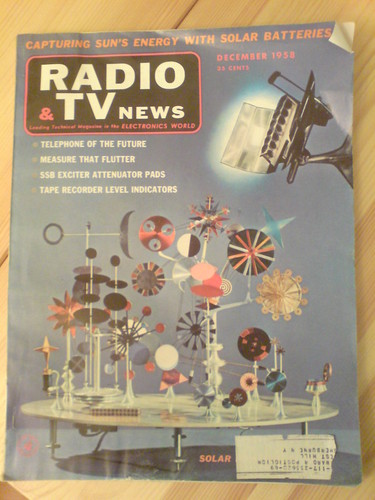
I’m fallen in love all over again with the Solar Toy Ray and Charles Eames created around 1956-7 for Alcoa.
Writing about it in 1958, Charles Eames also called it the “Do Nothing Machine.” As Steve Roden discussed a couple of years ago, Eames’s view of the functionless machine/toy was rather Zen: “It is not supposed to do. It is supposed to be. Its whole function is in its being.” Or, I would add, rather sculptural.
The Solar Toy was never meant for production, just promotion. As far as I know, a single unit was commissioned by Alcoa’s Oscar Shefler for the innovative-sounding “Forecast Collection.”
I’ve been stewing on it for more than three years now, and I think I must track down what happened to it, and what archives and records remain of its creation. And then I must either find it and exhibit it, or remake it and exhibit it. But either way, it should really be seen today.
Beyond the Toy’s sheer, self-evident beauty, it could shine a light, so to speak on some of the intellectual, cultural, technological, and environmental complexities of the intervening 50 years.
What has happened, how have we done since the archetypal prophet of American, can-do, corporate modernity dazzled us with his shiny, functionless object powered by the limitless energy of the sun?
Or as the article in Radio & TV News puts it in their cover story, “Will our future electricity all come from the sun?”
Intrigued by the possibilities of a future where man would use an energy source 93-million miles distant, Eames fashioned a design so that people may “see a living demonstration of the fantastic potential of the work that solar energy can perform for mankind.”
Fantastic! Let’s see how that turned out.
Note to self, even though I now have the print version of the magazine in my hand:
Some of the Solar Toy tech specs mentioned in Radio & TV News, Dec. 1958:
Heart of the unit is a bank of silicon solar cells made by International Rectifier Corp. Mounted in a reflector unit, oriented toward the sun by a unique tracking device, the cells are practical photo-voltaic devices…
Cells used are of the “p-n” type. The junction is formed on the wafer surface that is exposed to illumination and is composed of “n”-type and “p”-type semiconductor materials.
The “p”-type and “n”-type silicon are separated by a microscopic barrier layer, in which a built-in, permanent electric field exists…
A group of solar cells, arranged in a series-parallel configuration designed to give optimum power transfer to the load, becomes a solar battery…
On Eames’ Solar Toy, the converted energy drives a group of seven, German-made “Aristo” motors. The tiny 1 1/2- to 3-volt motors are each connected directly to a drive or crankshaft of the Toy.
One thing we know has improved in the last 50 years: we don’t need to explain the basics of semiconductors like p-n type junctions anymore, because they’re baked into everything in the world.
